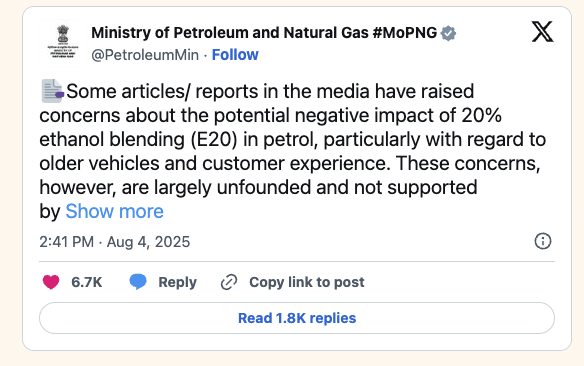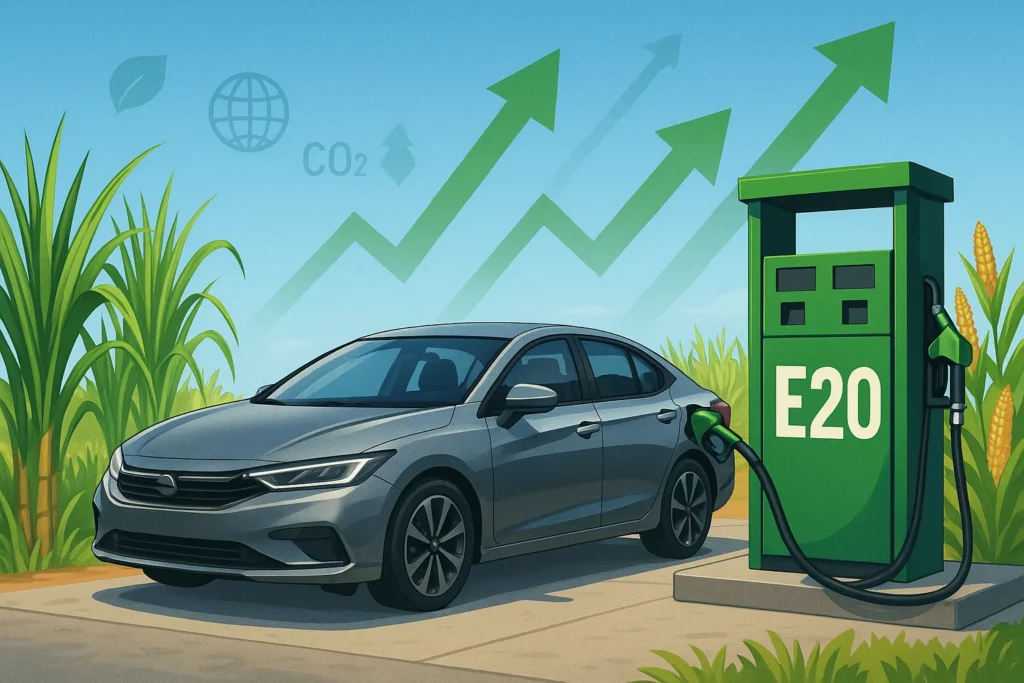Govt Refutes E20 Petrol Myths: Positive Outlook for Ethanol Stocks
When 20% ethanol-blended petrol (E20) started appearing at fuel pumps, many vehicle owners grew anxious.
“Will this new petrol damage my car engine?” some asked on social media. Others worried, “What if my mileage drops sharply? Older cars might not survive this change!”
These fears quickly spread, raising doubts not only among drivers but also among investors holding ethanol stocks. If E20 really harmed engines, demand for ethanol could slow, hitting sugar and biofuel companies.
But the government decided to address the noise with hard data. The Ministry of Petroleum and Natural Gas (MoPNG) released a detailed clarification. It shared results from extensive tests by ARAI, IIP, and Indian Oil R&D, which showed:
- No abnormal wear-and-tear in both old and new vehicles
- Only a marginal mileage drop of 1–2% for E10-designed cars and 3–6% for older models
- Smooth cold and hot starts with zero engine damage
In short, the government proved that the panic was misplaced. E20 is safe for engines, economical for the country, and green for the planet.

For the stock market, this is a positive trigger for ethanol stocks. The reassurance strengthens the long-term demand story for ethanol. Sugar companies, biofuel technology firms, and suppliers like Balrampur Chini, Praj Industries, Shree Renuka Sugars, and Triveni Engineering are likely to benefit as India stays on track for 20% blending by 2025. Investors now see E20 not as a threat, but as an opportunity for sustained growth in the ethanol ecosystem.
Government’s Proof and the Data Behind E20 Safety
As the debate around E20 heated up, the government didn’t just make statements—it brought evidence to the table. Officials pointed to years of vehicle testing, not just in India but also abroad.
Engineers from ARAI, Indian Oil R&D, and the Indian Institute of Petroleum (IIP) ran cars and bikes on ethanol-blended fuel for over 100,000 km. They checked for engine wear, performance drops, and fuel efficiency issues. The results told a clear story:
- Engines performed without any unusual damage
- Power and torque remained stable, even in older carbureted vehicles
- Fuel efficiency dropped only slightly, and mostly in older cars
- Hot and cold starts worked flawlessly
To further calm fears, the government addressed the mileage myth. Yes, ethanol has slightly lower energy density than petrol, which can lead to 1–2% lower mileage in E10-compatible cars and 3–6% in older models. But this drop is far from the “drastic fall” some feared on social media.
This clarity changed the narrative for the stock market too. Panic selling in sugar and ethanol companies could have erupted if the government had stayed silent. Instead, by proving that E20 is safe and sustainable, the ministry gave confidence to investors. Ethanol stocks now ride on a stronger story:
- Demand for ethanol stays intact, as India pushes towards 20% blending by 2025
- Sugar companies gain a new, stable revenue stream beyond sugar prices
- Biofuel technology players like Praj Industries see expanding opportunities for plant upgrades and new orders
This data-backed assurance positions ethanol not just as a green fuel, but also as a long-term growth engine for the stock market.
E20: A Win for Environment, Economy, and Stocks
After quelling safety concerns, the government turned the spotlight on why E20 matters beyond vehicles. The ethanol program isn’t just about blending fuel—it’s about reshaping India’s energy and economic landscape.
Every liter of ethanol blended into petrol means less crude oil imported. Since 2014-15, India has already saved over ₹1.4 lakh crore in foreign exchange by substituting petrol with ethanol. That money stays in the country, supporting local industries and farmers instead of flowing overseas to buy oil.
Then comes the environmental angle. Ethanol is cleaner than petrol, cutting carbon dioxide emissions by up to 65% when made from sugarcane and 50% when made from maize, as per a NITI Aayog study. For a country chasing net-zero goals, E20 is more than just fuel—it’s a climate-friendly solution.
And there’s the rural economy story. Every drop of ethanol represents income for farmers, whether it comes from sugarcane, surplus rice, or damaged food grains. With over ₹1.2 lakh crore paid to farmers in recent years for ethanol supply, this green fuel program also boosts rural employment.
For the stock market, these benefits create a long-term growth runway for ethanol stocks:
- Sugar producers like Balrampur Chini, Triveni Engineering, and Shree Renuka Sugars gain from steady ethanol demand and higher realizations.
- Biofuel technology companies like Praj Industries benefit as OMCs and sugar mills expand or upgrade their ethanol capacity.
- Energy security and green policies reduce business risk, which is attractive for long-term investors.
In essence, E20 is not just a fuel policy; it is a multi-dimensional growth story that ties together India’s climate goals, rural economy, and stock market opportunities.
Ethanol Stocks and Their Benefits from E20 Blending
| Company | Segment | Benefit from E20 |
|---|---|---|
| Balrampur Chini Mills | Sugar & Ethanol Producer | Higher ethanol demand ensures stable revenue beyond sugar price cycles; benefits from OMC supply deals. |
| Triveni Engineering | Sugar & Ethanol Producer | Ethanol sales improve margins; capacity expansion aligns with 20% blending target. |
| Shree Renuka Sugars | Sugar & Ethanol Producer | Boost from ethanol blending program; long-term contracts with OMCs secure earnings visibility. |
| Dwarikesh Sugar | Sugar & Ethanol Producer | Smaller player gaining from incremental ethanol allocation under E20 roadmap. |
| Praj Industries | Biofuel Tech & Ethanol Plants | Strong order book for ethanol plant setup and upgrades as demand accelerates. |
| India Glycols | Industrial & Fuel Ethanol | Diversified ethanol sales gain from increased blending mandates and industrial usage growth. |
| Oil Marketing Companies (IOC, BPCL, HPCL) | Fuel Retail & Blending | Save on petrol imports, boost green image, and benefit from government incentives on ethanol use. |
Conclusion: E20 Fuels Confidence in Ethanol Stocks
The debate over E20 petrol started with fear and confusion. Vehicle owners worried about engine damage, mileage loss, and costly repairs. But the government responded with clear evidence: extensive testing proved that E20 is safe, efficient, and environmentally responsible.
This shift in narrative does more than calm drivers—it energizes the stock market. Ethanol is no longer just an alternative fuel; it is a strategic growth engine for India’s economy. With lower crude imports, reduced emissions, and more income for farmers, the E20 roadmap strengthens the entire ethanol ecosystem.
For investors, this clarity translates into long-term confidence in ethanol stocks. Companies like Balrampur Chini, Triveni Engineering, Shree Renuka Sugars, and Praj Industries now stand on a strong policy foundation. Ethanol demand will keep rising, capacity expansion will create new revenue streams, and India’s green energy push will support valuations for years to come.
In short, what began as a social media scare has turned into a stock market opportunity. E20 blending doesn’t just fuel vehicles—it fuels a multi-dimensional growth story for India and a bullish outlook for ethanol stocks.
FAQs on E20 Petrol and Ethanol Stocks
1. Does E20 petrol damage car engines?
No. Government-backed tests by ARAI, IIP, and Indian Oil R&D show no abnormal wear or damage in vehicles using E20 petrol.
2. Will E20 petrol reduce fuel efficiency?
Only slightly. Cars designed for E10 may see a 1–2% drop, and older vehicles might experience 3–6% lower mileage, which is not drastic.
3. Which companies benefit from ethanol blending in India?
Key ethanol stocks include Balrampur Chini, Triveni Engineering, Shree Renuka Sugars, Praj Industries, and other sugar or biofuel players.
4. Why is E20 blending positive for the stock market?
E20 boosts ethanol demand, reduces crude imports, and supports rural income, creating long-term growth opportunities for ethanol-linked companies.
5. What is the long-term outlook for ethanol stocks?
Bullish. India targets 20% blending by 2025, which means sustained ethanol demand, capacity expansion, and stable revenue streams for leading players.
Related Articles
Space Stock: Indian Companies Set to Soar
Indian Biotechnology Sector: A $300 Billion Opportunity in the Making
Defence Stocks After the Rally: Hold, Book Profits, or Buy the Dip?






